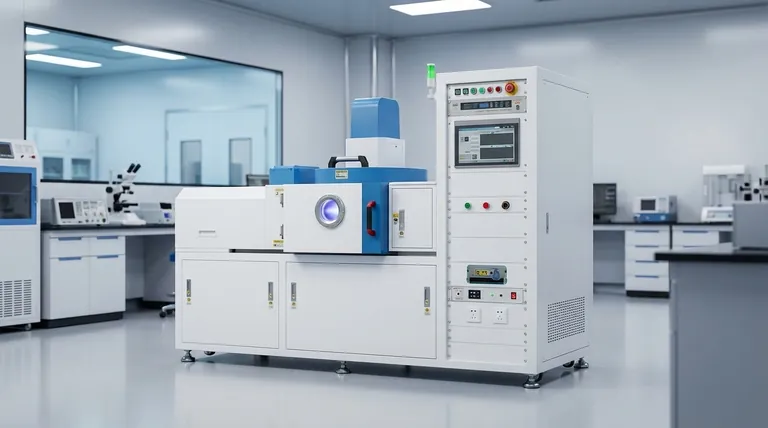In short, the Physical Vapor Deposition (PVD) process involves three core steps performed inside a vacuum chamber: a solid source material is converted into a vapor, this vapor travels across the chamber, and it then condenses onto the target object (the substrate) as a thin, high-performance coating.
At its core, PVD is a physical transportation process, not a chemical one. It physically moves atoms from a source to a substrate without altering their chemical nature, relying on high energy and a vacuum to create a pure, strongly adhered thin film.

The Three Foundational Stages of PVD
The entire PVD process can be broken down into three distinct and critical stages. Each step must be precisely controlled to achieve the desired coating properties.
Stage 1: Vaporization (Creating the Vapor)
The first step is to convert a solid source material, known as the "target," into a gaseous vapor. This is the defining stage that distinguishes different PVD methods.
The two primary methods for this are sputtering and thermal evaporation.
In sputtering, high-energy particles (typically ions from a plasma) are used to bombard the target material, physically knocking atoms off its surface.
In thermal evaporation, the target material is heated using methods like resistive heating or an electron beam until it boils and "evaporates" into a vapor.
Stage 2: Transport (The Vacuum Journey)
Once vaporized, the atoms or molecules travel from the source material to the substrate you intend to coat.
This entire process must occur in a high-vacuum environment. The vacuum is critical because it removes air and other particles that could contaminate the coating or impede the vapor's path.
This ensures the vapor travels in a straight line—a "line-of-sight" journey—and deposits as a pure material onto the substrate.
Stage 3: Deposition (Condensation and Growth)
In the final stage, the vaporized material reaches the cooler surface of the substrate and condenses back into a solid state.
This condensation builds up, atom by atom, to form a thin, dense, and tightly bonded film on the surface of the object. The substrate is often manipulated or rotated to ensure even coverage.
PVD vs. CVD: A Critical Distinction
It is vital to distinguish PVD from its counterpart, Chemical Vapor Deposition (CVD), as they operate on fundamentally different principles.
The PVD Principle: Physical Transfer
As described, PVD is a mechanical or thermal process. It physically moves material from point A to point B. No chemical reactions are intended to occur during the process.
The CVD Principle: Chemical Reaction
In contrast, CVD introduces reactive gases into a chamber. These gases undergo chemical reactions on the substrate's surface, and the solid product of that reaction forms the film. This is a chemical process, not a physical one.
Common Pitfalls and Considerations
While powerful, the PVD process has inherent characteristics that create trade-offs you must consider for any application.
The "Line-of-Sight" Limitation
Because the vaporized material travels in a straight line, PVD is best suited for coating flat or smoothly curved surfaces.
It is difficult to achieve a uniform coating on complex shapes with hidden corners or deep crevices. This is a key area where chemical-based processes like CVD can have an advantage.
Adhesion and Surface Preparation
While PVD is known for producing films with good adhesion, this is highly dependent on the cleanliness and preparation of the substrate.
Any surface contaminants like oils or oxides will prevent the coating from bonding properly, leading to film failure. Rigorous cleaning is a non-negotiable prerequisite.
Making the Right Choice for Your Goal
Understanding these core principles allows you to determine if PVD is the correct approach for your specific need.
- If your primary focus is coating planar surfaces with pure metals or simple alloys: PVD is an excellent, direct, and high-purity choice known for its strong adhesion.
- If your primary focus is creating uniform coatings on complex 3D parts: You should investigate a chemical-based method like CVD, which is not limited by line-of-sight deposition.
- If your primary focus is depositing materials with extremely high melting points: PVD methods like sputtering or e-beam evaporation are often superior as they do not rely on simple thermal heating to create vapor.
Ultimately, recognizing PVD as a controlled, line-of-sight physical transfer process is the key to leveraging its unique strengths for your project.
Summary Table:
| Stage | Key Process | Purpose |
|---|---|---|
| 1. Vaporization | Sputtering or Thermal Evaporation | Converts solid target material into a vapor |
| 2. Transport | Line-of-sight travel in a vacuum | Ensures pure, uncontaminated vapor transfer |
| 3. Deposition | Condensation onto the substrate | Forms a dense, strongly adhered thin film |
Ready to leverage PVD technology for your lab's coating needs? KINTEK specializes in high-performance lab equipment, including PVD systems, to help you achieve precise, pure, and durable thin films. Our experts can guide you to the right solution for your specific application. Contact us today to discuss how we can enhance your research or production capabilities!
Visual Guide

Related Products
- RF PECVD System Radio Frequency Plasma-Enhanced Chemical Vapor Deposition RF PECVD
- Split Chamber CVD Tube Furnace with Vacuum Station Chemical Vapor Deposition System Equipment Machine
- Chemical Vapor Deposition CVD Equipment System Chamber Slide PECVD Tube Furnace with Liquid Gasifier PECVD Machine
- VHP Sterilization Equipment Hydrogen Peroxide H2O2 Space Sterilizer
- Molybdenum Tungsten Tantalum Special Shape Evaporation Boat
People Also Ask
- What is an example of PECVD? RF-PECVD for High-Quality Thin Film Deposition
- How does RF power create plasma? Achieve Stable, High-Density Plasma for Your Applications
- What is the principle of plasma enhanced chemical vapor deposition? Achieve Low-Temperature Thin Film Deposition
- What is plasma activated chemical vapour deposition method? A Low-Temperature Solution for Advanced Coatings
- What are the benefits of PECVD? Achieve Superior Low-Temperature Thin Film Deposition



















